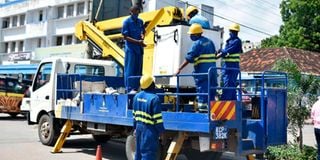Kenya Power monopoly nearing end as ministry splits supply role

Kenya Power technicians carry out repairs on a transformer on Haile Selassie Road in Mombasa on December 5, 2020.
Kenya Power is marked for a major split in its business that will see it only distribute electricity to large commercial and industrial consumers as part of proposed reforms by the Ministry of Energy to boost efficiency and cut costs.
A White Paper published by the ministry shows that the Rural Electrification and Renewable Energy Corporation (Rerec) will take over the role of distributing electricity to household consumers, relieving Kenya Power (KPLC) of the pressure of juggling between serving industrialists who account for more than half its sales and millions of household customers who take up about a third of dispatched power.
“Reconfigure KPLC and Rerec across consumer segments so that KPLC is positioned to serve large commercial and industrial consumers, while Rerec is positioned to serve the social mandate for household consumers,” the paper published by Energy Principal Secretary Gordon Kihalangwa recommends.
Rerec is currently mandated to implement rural electrification projects and spearhead uptake of green energy, except geothermal.
Dr Kihalangwa said the proposal is subject to public participation. “We’re seeking stakeholders’ view on this matter after which we will develop a work plan and timelines of implementation. It is work in progress,” he said.
The paper recommends secondment of KPLC staff to Rerec to help with the transition and an audit of KPLC distribution assets to smoothen the changeover.
The latest data by the Energy and Petroleum Regulatory Authority (Epra) shows that KPLC added some 317,296 customers in the six months to December as the economy continued to recover from Covid-19 disruptions.
Read: The rot at Kenya Power
The utility had 8.59 million customers by the end of last year, from 8.27 million in June 2021, according to Epra. The additional customers helped raise electricity unit sales by 8.7 per cent to 4,562 Gigawatt hours.
If implemented, this would be the second major shake-up of KPLC operations in less than a year after Epra in December 2021 removed it from a key role that determined the amount and type of electricity dispatched to the national grid. The changes will have an impact on Kenya Power’s revenue base and cost structure. Households will be hoping that Rerec will improve on reliability of Kenya Power’s supply, which is affected by its ageing infrastructure.
In the 2021 changes, the Kenya Electricity Transmission Company (Ketraco) took over the operations of the National Energy Control Centre (NCC), which manages the uptake of energy from various sources for distribution on the national grid, to curb conflict of interest and seal loopholes abused by some cartels to force costly power on consumers.
“Ketraco, as a system operator, will be responsible for the following functions: managing and operating the national control centre and other infrastructure established by the national government for the purpose of carrying out system operation,” Epra said when it announced the changes.
Under the new role, Ketraco is now also tasked with determining the best mix of cost-friendly electricity supplied to the grid.
KPLC had for decades managed the NCC amid complaints that some of its rogue staff colluded with some independent power producers to load large quantities of expensive thermal power on the grid even when there were cheaper options from sources such as geothermal.
For instance, KPLC was in 2020 at the centre of a storm for prioritising expensive thermal power over cheaper options such as geothermal and hydro, effectively setting up consumers for higher electricity prices.
This followed a data release by Epra that showed that the power distributor had in September last year taken the highest proportion of the expensive thermal power in more than a year while reserving the lowest slot for the cheaper geothermal power.
It was established that, in total, KenGen’s available geothermal capacity for the month was 499.7 megawatts (MW), against 410.3MW taken up by the off-taker. This means we had an additional 89.4MW that was not taken up. As a result, consumers paid a higher fuel cost charge—which is influenced by the share of electricity from diesel generators—of Sh2.6 per kilowatt-hour (kWh), up from the Sh2.4 in May 2020.
A task force appointed by President Uhuru Kenyatta in March 2020 to review Power Purchase Agreements (PPAs) flagged the anomalies in the operations of NCC and recommended that KPLC be removed from managing the key role to curb abuse.





